The fahaka puffer, also known as the Nile puffer (Tetraodon lineatus), is a freshwater fish that is not commonly found in aquarist tanks. This large puffer fish is native to the Nile River and is recognized for its distinct appearance and behavior. All tetraodon species possess strong teeth, which the fahaka puffer uses to tear pieces from its tank mates, highlighting its carnivorous nature.
Keeping fahaka puffers can be particularly challenging and is generally recommended for experienced aquarists. These fish have specific environmental needs, including tank size, water quality, and dietary requirements. Their aggressive behavior can also pose difficulties, making it essential for keepers to understand the intricacies of their care before introducing them to a community tank.
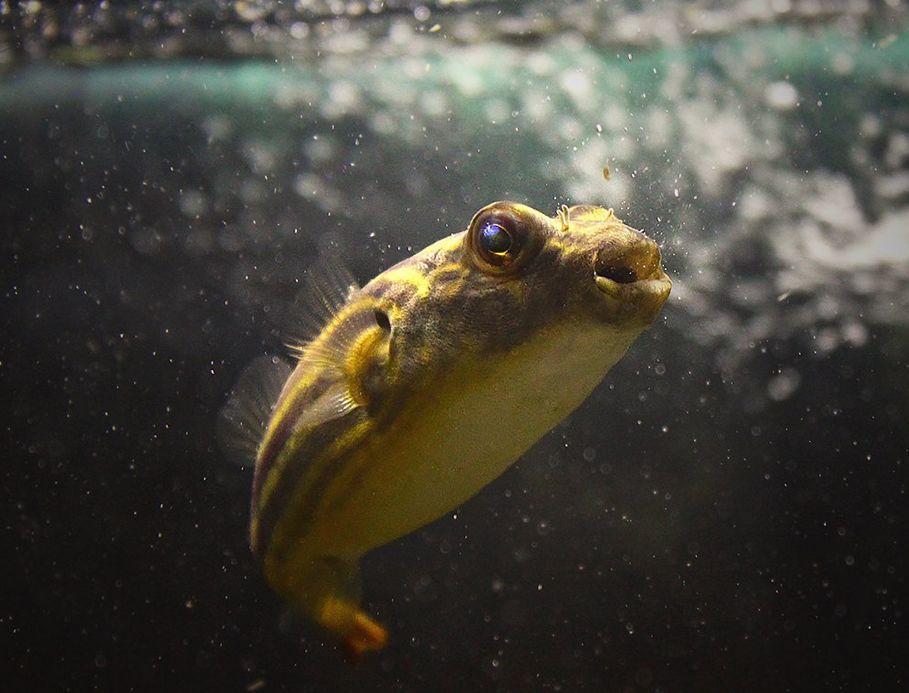
Contents
Habitat in the wild
The fahaka puffer (Tetraodon lineatus) is a fascinating member of the Tetraodontidae family, commonly known as the pufferfish family. This family encompasses over 120 species found in both freshwater and marine environments worldwide. Pufferfish are notable for their unique ability to inflate their bodies by ingesting water or air, transforming into a balloon-like shape as a defense mechanism against predators. Additionally, they possess beak-like teeth and strong jaws, allowing them to crush the shells of their prey.
As a tropical freshwater demersal (bottom-living) fish, the fahaka puffer inhabits large rivers and surface waters across West, East, and Northeast Africa. They are commonly found in countries such as Egypt, Sudan, Chad, and Nigeria, with notable populations in the Nile Basin, including the White Nile, Lake Turkana, Lake Nasser (Sudan), the Baro River (Ethiopia), and the Niger, Volta, Gambia, Geba, and Senegal rivers.
Fahaka puffers thrive in slow-moving or stagnant waters, including river channels, floodplains, and backwaters. They prefer areas rich in dense vegetation, submerged plants, and hiding spots, such as fallen trees and rock formations. These fish can be found in both clear and turbid waters, showcasing their adaptability.
In terms of environmental conditions, the natural habitat of fahaka puffers varies widely. They inhabit freshwater and slightly brackish waters, where the water typically has a moderate pH level. The preferred temperature range for these fish is around 75°F to 82°F (24°C to 28°C). While the fahaka puffer is primarily a freshwater species, it has shown some tolerance for low salinity levels, although it is rarely found in fully marine environments.
Description
The fahaka puffer (Tetraodon lineatus) features a long, slender body shape that sets it apart from other pufferfish species, which typically have rounder forms. This species has a cylindrical body with a tapered snout. Like all tetraodon species, coloration varies based on age, environment, and mood. Juveniles tend to be more brightly colored, while adults exhibit more contrasting hues.
The eyes of fahaka puffers are positioned on the top of their heads, giving them a distinctive appearance. This eye placement enhances their ability to observe their surroundings and search for prey from an advantageous angle.
Fahaka puffers possess a unique beak-like mouth with strong, protruding teeth that are specially adapted for crushing and grinding the hard shells of their prey, such as snails and crustaceans. Within their jaws, they have specialized dental plates made of fused teeth, forming a sturdy structure that facilitates shell-crushing. These plates work together to apply significant force, allowing the puffer to access the soft tissues inside the shells.
Tetraodons are well-known for their remarkable ability to ‘puff up’ by ingesting air or water when they perceive danger. Their bodies are covered with small spines or prickles, which become more pronounced when the fish is agitated or aggressive. These spines can be raised or flattened depending on the fish’s mood. When the fahaka puffer inflates, the spines extend outward, making it difficult for predators to swallow such a prickly meal. Additionally, like all puffers, the fahaka puffer is toxic.
Are Fahaka Puffers Poisonous?
It is essential to remember that tetraodons, including the fahaka puffer, are poisonous. Direct contact with them is strongly discouraged.
Fahaka puffers contain a potent neurotoxin called tetrodotoxin (TTX), which is primarily found in their liver, intestines, and ovaries. This toxin acts as a defense mechanism against potential predators. Interestingly, the toxin is not produced by the pufferfish itself; instead, it accumulates through its diet, which includes certain marine organisms such as specific bacteria and algae.
Tetrodotoxin is highly toxic to humans and many other animals, ranking among the most potent naturally occurring toxins, with no known antidote. Exposure or ingestion can lead to severe symptoms, including paralysis, respiratory failure, and potentially death.
Due to the presence of this toxin, it is crucial to handle fahaka puffers with extreme caution and avoid contact with their bodily fluids. It is highly advised not to consume or prepare fahaka puffers for human consumption unless performed by trained and licensed individuals who know how to safely remove the toxin.
While the toxin poses a significant risk, following appropriate safety precautions and handling protocols minimizes the chances of exposure. It is essential to educate oneself and adhere to proper safety measures when dealing with fahaka puffers or any other species of pufferfish.
Size
The fahaka puffer (Tetraodon lineatus) is known for its relatively large size compared to many other pufferfish species. When fully grown, fahaka puffers can reach impressive lengths of up to 18 inches (45 cm). This substantial size makes them a striking addition to any aquarium, though it also necessitates a spacious tank to accommodate their needs.
How Fast Do Fahaka Puffers Grow?
The growth rate of fahaka puffers can vary based on several factors, including diet, water quality, and overall care. Generally, fahaka puffers are considered relatively slow-growing fish compared to some other species. In their first year, they may experience more rapid growth; however, their growth rate typically slows as they mature.
On average, it is not uncommon for fahaka puffers to take several years to reach their maximum size. The timeline for growth can depend significantly on their environmental conditions and care.
A varied and nutritious diet is crucial for promoting healthy growth. Fahaka puffers thrive on meaty foods such as snails, shrimp, and fish. Offering a diverse diet not only supports their growth but also contributes to their overall health. Additionally, maintaining optimal water conditions, providing adequate tank space, and ensuring good overall health can further enhance their growth potential.
Lifespan
The fahaka puffer (Tetraodon lineatus) has the potential for a relatively long lifespan compared to many other aquarium fish species. With proper care and a suitable environment, these fish can live for 10 to 15 years, and in some cases, they may even exceed this lifespan. This longevity makes them a rewarding choice for dedicated aquarists who are prepared to meet their specific needs.
| Characteristic | Description |
|---|---|
| Scientific Name | Tetraodon lineatus |
| Common Names | Fahaka puffer, Nile puffer |
| Size | Up to 18 inches (45 cm) in length |
| Body Shape | Long and slender |
| Coloration | Dark green or grayish-brown body with small spines or prickles |
| Eye Position | Eyes positioned on the top of the head |
| Diet | Carnivorous, feeds on meaty foods like snails, shrimp, fish |
| Behavior | Highly territorial and aggressive |
| Tank Size | Minimum of 100 gallons or larger for adult individuals |
| Water Conditions | Freshwater or slightly brackish water, moderate pH |
| Habitat | Freshwater rivers and lakes of Africa |
| Natural Range | Nile River, Lake Chad basin, found in countries like Egypt, Sudan, Chad, Nigeria |
| Conservation Status | Not evaluated or classified by the IUCN |
| Caution | Contains the toxin tetrodotoxin, handle with care |
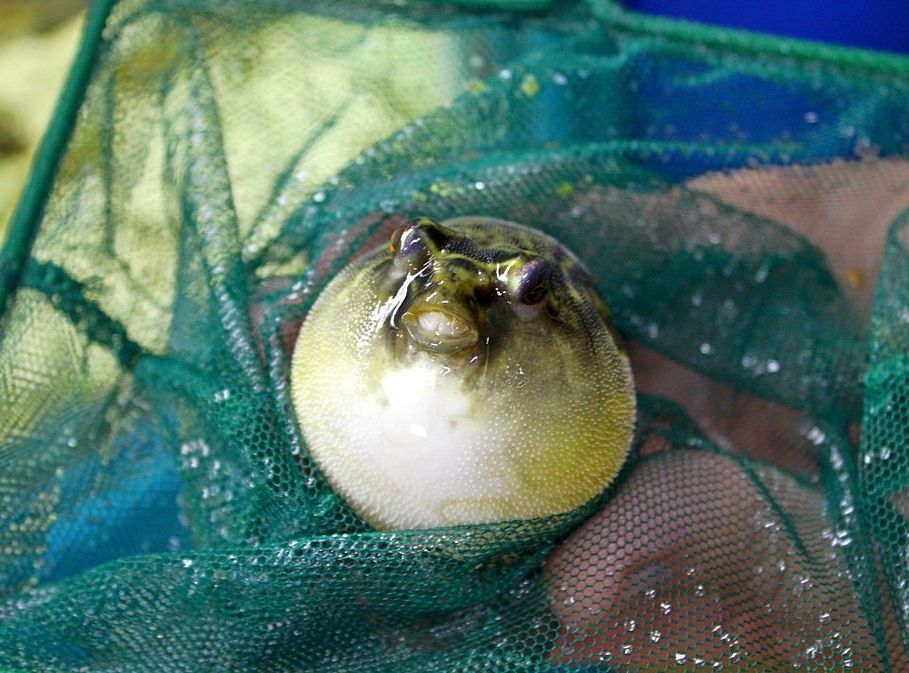
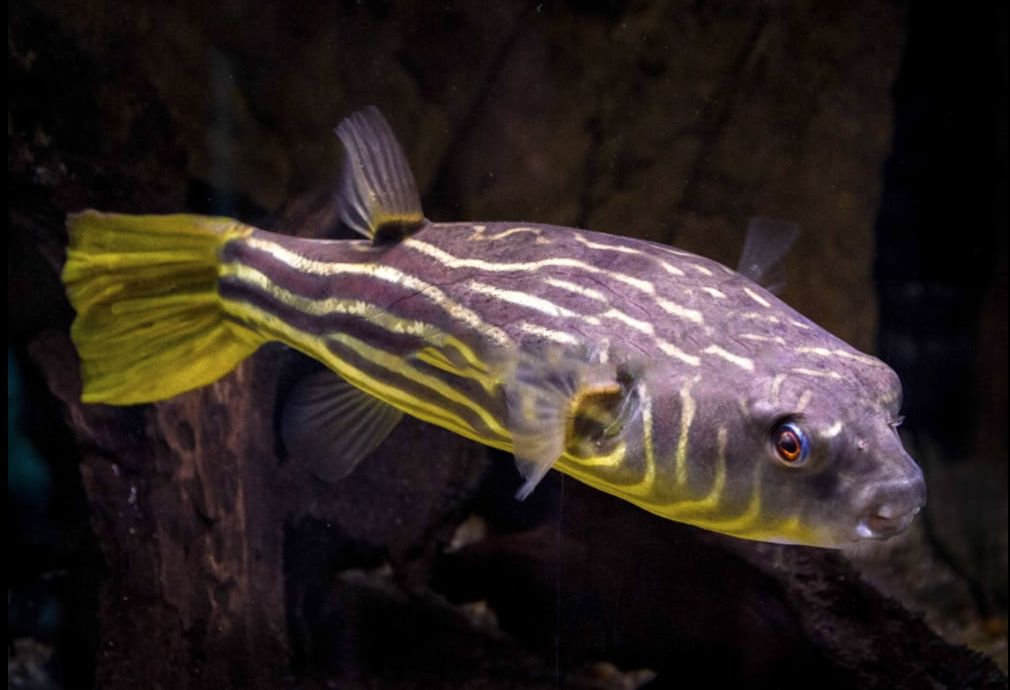
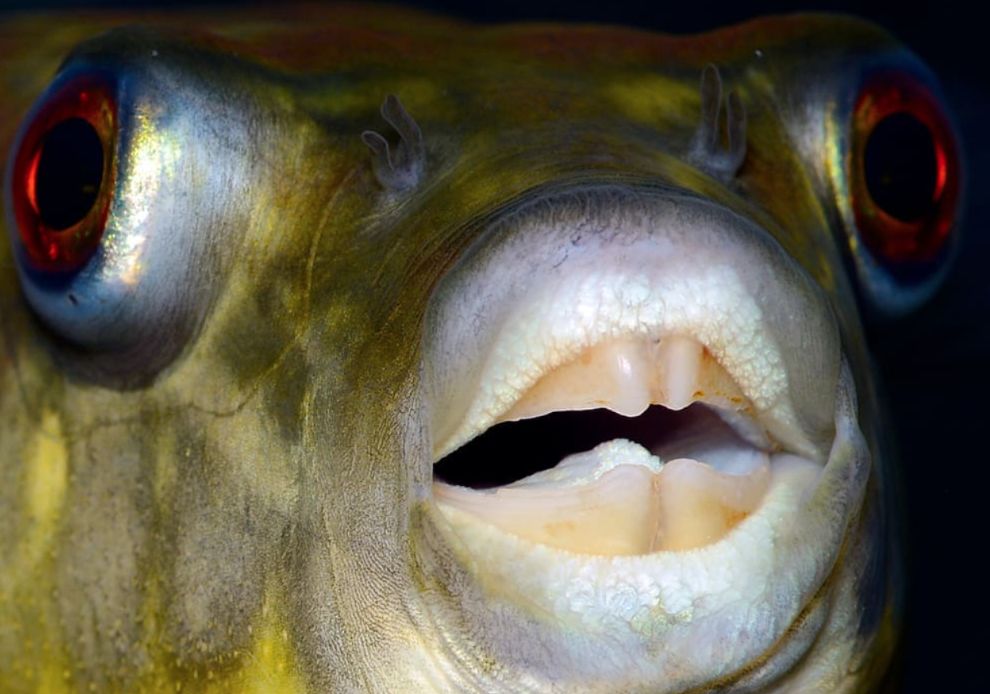
Difficulties in keeping
Caring for the fahaka puffer (Tetraodon lineatus) is manageable, provided you create an appropriate tank environment and maintain optimal conditions. However, their care comes with specific requirements due to their aggressive nature and particular needs.
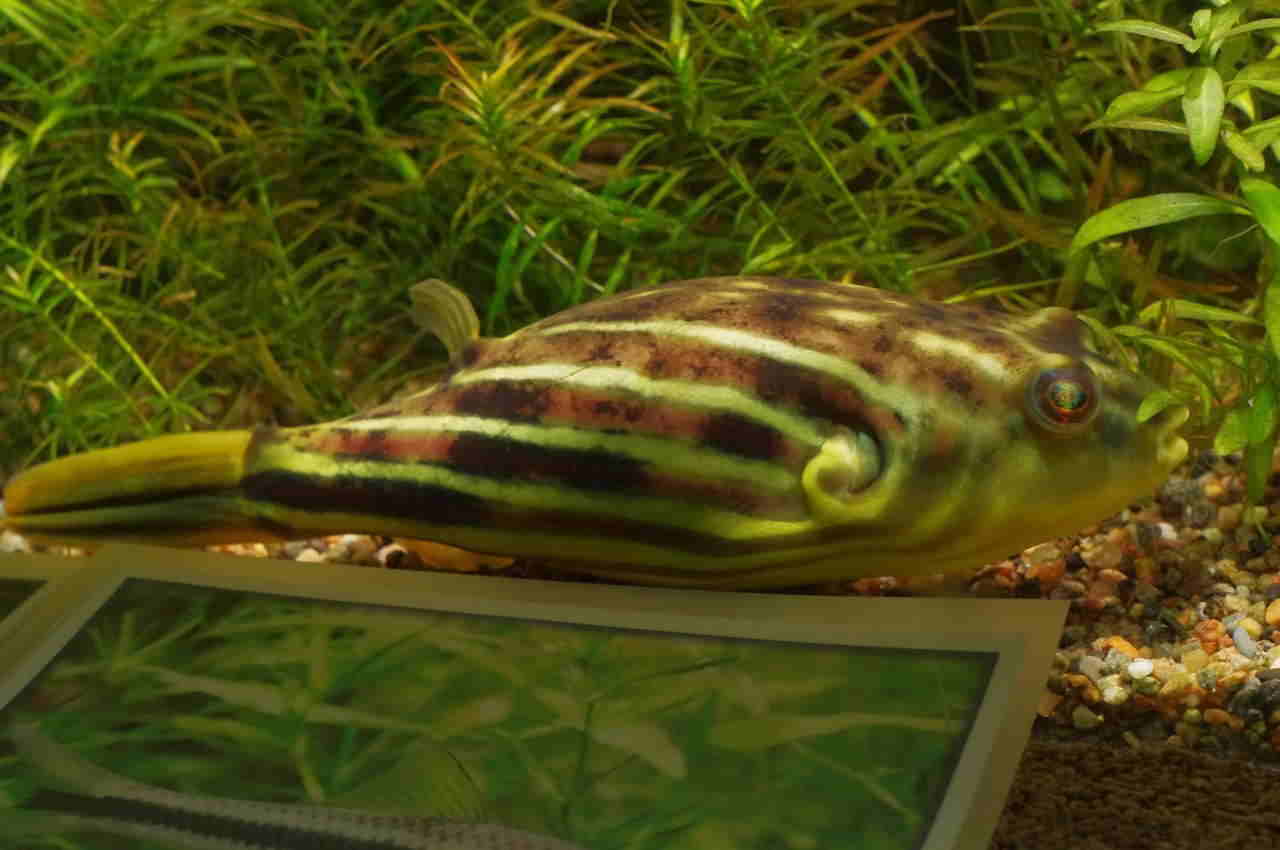
Care and keeping in a tank
Tank size
Fahaka puffers are large fish that require a spacious tank to meet their needs. Due to their high growth rate, these fish can reach a maximum size of up to 45 cm (18 inches). Therefore, it is essential to provide a tank of at least 100 gallons or larger for adult fahaka puffers.
These fish are active swimmers, necessitating ample space to move freely. A larger tank allows them to exhibit natural behaviors and comfortably explore their environment. Additionally, fahaka puffers can be territorial and often display aggression, particularly towards other pufferfish. A spacious tank helps establish separate territories within the aquarium, reducing the likelihood of conflicts and aggressive encounters.
While fahaka puffers are typically kept in species-only tanks due to their aggressive nature, they can coexist with larger, robust fish that can tolerate their temperament. A larger tank provides enough room for potential tank mates to establish their own territories, minimizing the risk of aggression-related injuries.
Larger tanks also offer more stability in terms of water parameters and are easier to maintain regarding filtration and water quality. Since fahaka puffers produce significant waste, a well-filtered tank is essential for maintaining optimal conditions. It is important to note that tank size recommendations serve as general guidelines. Individual circumstances may vary, so closely observing the behavior and well-being of your fish is crucial to ensuring a healthy environment.
Substrate
The best tank substrate for the fahaka puffer is sand, as it closely mimics their natural riverbed or lakebed environments. This substrate allows them to exhibit natural digging and foraging behaviors, which are important for their overall well-being. When choosing sand, ensure it is smooth and free from sharp edges to prevent any injuries to the puffer’s delicate belly.
If you prefer a substrate with slightly larger particles, smooth gravel can be an alternative. However, it’s crucial to select gravel pieces that are small and rounded, as larger particles may pose a risk of accidental ingestion while the puffer hunts for food.
Some aquarists opt for a bare-bottom tank setup for fahaka puffers. This substrate-free approach simplifies tank maintenance and eliminates the risk of substrate ingestion.
Ultimately, the choice of substrate for a fahaka puffer tank should reflect your preferences and the specific needs of the fish. Regardless of the substrate you select, prioritize the puffer’s safety and well-being by ensuring that the materials are smooth, free from sharp edges, and easy to clean.
Water parameters
To provide appropriate water parameters for the fahaka puffer (Tetraodon lineatus), it’s essential to consider their natural habitat and replicate those conditions as closely as possible. Notably, there’s no need to add any salt to the water, as the fahaka puffer is primarily a freshwater tetraodon.
Fahaka puffers thrive in a water temperature range of 75°F to 82°F (24°C to 28°C). Maintaining a stable temperature within this range is vital for their overall well-being. They prefer slightly alkaline to neutral water conditions, so aim for a pH level between 7.5 and 8.5. Regular monitoring of pH levels, along with appropriate buffering if needed, is recommended to maintain stable conditions.
In terms of water hardness, fahaka puffers can tolerate moderate to high levels, with a hardness level between 10 to 20 dGH (German degrees of hardness) being ideal. This range helps replicate their natural habitat, and some degree of hardness is beneficial for their overall health.
While fahaka puffers are primarily freshwater fish, they have been known to tolerate low levels of salinity. However, it is generally recommended to keep them in freshwater rather than brackish or marine conditions, as maintaining stable freshwater parameters is usually the safest option.
Fahaka puffers are sensitive to poor water quality, so excellent filtration and regular water changes are crucial. Aim for zero levels of ammonia and nitrite, and keep nitrate levels below 20 ppm. Regular testing of water parameters is essential for the health of the puffers, especially since they are messy eaters and often leave leftovers after meals. As such, a strong external filter that can pump 6 to 10 tank volumes per hour is recommended to maintain optimal water quality.
Lastly, remember that water parameters should be gradually adjusted, as sudden changes in water conditions can stress the puffers. By replicating their natural habitat and maintaining stable, high-quality water conditions, you can ensure the health and well-being of your fahaka puffer.
Decor
The fahaka puffer is likely to damage any live tank plants, so it’s advisable not to invest time in planting them. Instead, incorporating artificial plants can enhance the aesthetic appeal of the tank while providing cover and shelter for the puffers.
For the tank setup, consider using smooth rocks, driftwood, and sandstones. Adding rocks and driftwood can create hiding spots and help establish a natural-looking environment. Ensure that the rocks are securely positioned to prevent them from toppling over and potentially injuring the fish. Driftwood not only offers additional hiding places but also creates interesting structures for the puffers to explore.
While providing hiding spots is essential, it’s equally important to leave open swimming space for the puffers. This open area allows them to exercise and explore their tank freely. Avoid overcrowding the tank with decorations to ensure there is ample space for swimming.
Diet
In the wild, fahaka puffers feed on a variety of prey, including insects, shellfish, and other spineless species. Therefore, in captivity, they thrive on a diet that includes snails, crabs, and crawfish, particularly those with hard shells. Additionally, they can be fed small fish and frozen krill meat. For juveniles, it is advisable to provide food every other day; as they mature, this can be reduced to 2-3 times a week.
The diet of fahaka puffers changes as they grow. Juveniles typically consume snails, prawns, and frozen foods, while adults—those over 16 cm in length—should be offered larger prawns, crab legs, and fish fillets. While live fish can also be fed to fahaka puffers, this practice carries a risk of introducing parasites and illnesses.
Fahaka puffers possess strong teeth that continue to grow throughout their lives. To ensure proper dental health, it is important to provide them with snails and crustaceans, as these help wear down their teeth naturally. If their teeth grow too long, the puffer may struggle to feed, necessitating manual trimming.
Suitable food options for fahaka puffers include:
- Live or Frozen Foods: Fahaka puffers readily accept both live and frozen foods. Some common options include:
- Snails: Snails are a staple in their diet. Offer a variety of safe snail species, such as ramshorn snails, Malaysian trumpet snails, and pond snails, ensuring they are free from pesticides. Snails not only provide nutrition but also serve as a natural dental care tool.
- Shrimp: Small, whole shrimp, like ghost shrimp or freshwater shrimp, are excellent options. Be sure to remove any sharp parts, such as the rostrum, to prevent injury. Shrimp offer a good source of protein and can be a fun food for the puffer to hunt.
- Fish: Small whole fish, including feeder fish, guppies, or small mollies, can also be provided. Ensure these fish are appropriately sized and free from parasites or diseases. While these can be an exciting meal for the puffer, caution should be taken to monitor for any potential health issues that may arise from feeding live fish.
Tank mates
Choosing tank mates for fahaka puffers (Tetraodon lineatus) can be challenging due to their aggressive and territorial nature. Fahaka puffers are known to be highly aggressive towards other fish, including conspecifics (other pufferfish), and may pose a threat to smaller or more passive tank mates. Fahaka puffer is a very aggressive fish, so it should be kept alone in a tank or with large, aggressive fish that can hold their own. There were some cases when the fish was successfully kept together with other fishes, but it was only in very big tanks and tank mates were so fast, that the fish couldn’t catch them (but it’s not african cichlids!) or fishes like arowana.
The fish can be kept in one tank with related species only if they have enough space for each of them to avoid any contact, otherwise there will be a fight each time they see each other. The fahaka puffer is very intelligent and it seems as if it communicates with its owner due to its unique mimics.
Gender differences: male vs female
Distinguishing between male and female Tetraodon lineatus can be quite challenging, especially when the fish are not yet sexually mature. Unfortunately, sexual dimorphism—visible physical differences between males and females—is not well-documented in fahaka puffers, and there are no reliable external characteristics to differentiate between the sexes.
While it is generally impossible to tell male and female fahaka puffers apart at a glance, some changes become noticeable during the spawning period. During this time, females tend to become more rounded than males, which may serve as a subtle indicator of their sex. However, without close observation and experience, even these differences can be difficult to detect.
Breeding
Currently, there is no commercial breeding of fahaka puffers, although some dedicated aquarists have successfully raised juveniles in captivity. The primary challenge in breeding this tetraodon lies in its aggressive nature, which complicates pairing and maintaining the necessary conditions for spawning.
In their natural habitat, fahaka puffers breed in deeper waters, making it nearly impossible to replicate these specific conditions in a home aquarium. The substantial adult size of these fish further complicates the situation, as their tank requirements are significantly larger than what is typically available for breeding setups.
For aquarists interested in breeding fahaka puffers, understanding these challenges is crucial. It requires not only a well-designed environment but also a commitment to monitoring and adjusting water parameters to mimic their natural spawning conditions as closely as possible.
Interestingly, fahaka puffers engage in elaborate courtship displays during mating season. Males often swim in circles around females, showcasing their coloration and size to attract a mate. This display of dominance is essential, as only the most robust and fit males typically succeed in winning the attention of females.
The lack of commercial breeding means that most fahaka puffers available in the market are wild-caught, which can impact their health and adaptability in captivity. Wild-caught fish often come with the stress of transport and may carry parasites or diseases, making them more challenging to care for.
Successful breeding attempts in captivity often involve creating a breeding environment with plenty of hiding spots and territories to help reduce aggression during the spawning process. Incorporating smooth rocks, driftwood, and artificial plants can provide necessary shelter and stimulate natural behaviors.
It’s also important to note that juvenile fahaka puffers can be particularly vulnerable to stress and disease. Providing stable water parameters, a balanced diet, and a low-stress environment is vital for their survival as they grow.